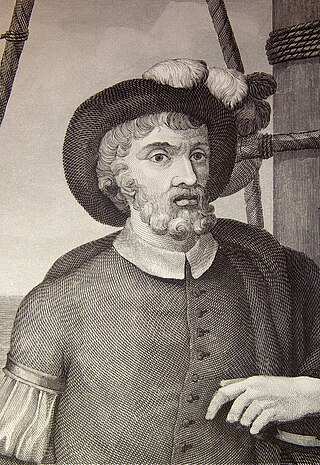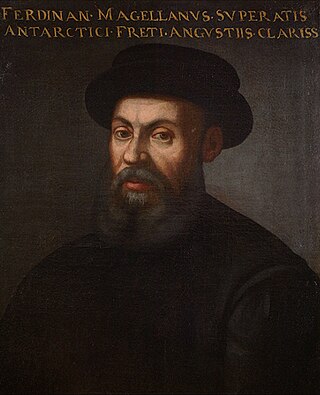
Juan Sebastián Elcano was a Spanish navigator, ship-owner and explorer of Basque origin from Getaria, part of the Crown of Castile when he was born, best known for having completed the first circumnavigation of the Earth in the Spanish ship Victoria on the Magellan expedition to the Spice Islands. He received recognition for his achievement by Charles I of Spain with a coat of arms bearing a globe and the Latin motto Primus circumdedisti me.
Ruy López de Villalobos was a Spanish explorer who led a failed attempt to colonize the Philippines in 1543, attempting to assert Spanish control there under the terms of the treaties of Tordesillas and Zaragoza. Unable to feed his men through barter, raiding, or farming and unable to request resupply from Mexico due to poor knowledge of the Pacific's winds and currents, Villalobos abandoned his mission and fled to the Portuguese-held Moluccas, where he died in prison. He is chiefly remembered for some sources crediting him with naming Leyte the "Philippine Island" in honor of the Spanish crown prince Philip. The name was later extended across the entire Philippine Archipelago and its nation.

Enrique of Malacca, was a Malay member of the Magellan expedition that completed the first circumnavigation of the world in 1519–1522. He was acquired as a slave by the Portuguese explorer Ferdinand Magellan in 1511 at the age of 14 years, probably in the early stages of the capture of Malacca. Although Magellan's will calls him "a native of Malacca", Antonio Pigafetta states that he was a native of Sumatra, Indonesia. Magellan later took him to Europe, where he accompanied the circumnavigation expedition in 1519. According to some historians, it is possible that he could be the first person to circumnavigate the globe and return to his starting point, however, there is no record or source that confirms it.

Antonio Pigafetta was a Venetian scholar and explorer. He joined the Spanish expedition to the Spice Islands led by Portuguese explorer Ferdinand Magellan, the world's first circumnavigation, and is best known for being the chronicler of the voyage. During the expedition, he served as Magellan's assistant until Magellan's death in the Philippine Islands, and kept an accurate journal, which later assisted him in translating the Cebuano language. It is the first recorded document concerning the language.

Victoria or Nao Victoria was a carrack famed as the first ship to successfully circumnavigate the world. Victoria was part of the Spanish expedition to the Moluccas commanded by the explorer Ferdinand Magellan.

Francisco Serrão was a Portuguese explorer and a possible cousin of Ferdinand Magellan. His 1512 voyage was the first known European sailing east past Malacca through modern Indonesia and the East Indies. He became a confidant of Sultan Bayan Sirrullah, the ruler of Ternate, becoming his personal advisor. He remained in Ternate where he died around the same time Magellan died.
Rui (Ruy) Faleiro, also known as Ruy de Faleira, was a Portuguese cosmographer, astrologer, and astronomer who was the principal scientific organizer behind Ferdinand Magellan's circumnavigation of the world.

Estêvão Gomes, also known by the Spanish version of his name Esteban Gómez, was a Portuguese explorer. He sailed in the service of Castile (Spain) in the fleet of Ferdinand Magellan, but deserted the expedition when they had reached the Strait of Magellan and returned to Spain in May 1521. In 1524, he explored the coast of present-day New England and Nova Scotia. As a result of Gomes' expedition, cartographer Diogo Ribeiro was the first to accurately portray North America with a continuous coastline stretching from Florida to Nova Scotia.
Ginés de Mafra was a Spanish mariner who sailed with the Magellan expedition in search of a western passage to Asia. His later account of the voyage is an important supplement to the historical record. In 1536 he served as the chief pilot for Pedro de Alvarado on a voyage to Peru and in 1542 he sailed with Ruy López de Villalobos to the Philippines.

Between 1492 and 1504, Italian explorer Christopher Columbus led four Spanish transatlantic maritime expeditions of discovery to central and South America. These voyages led to the widespread knowledge of the New World. This breakthrough inaugurated the period known as the Age of Discovery, which saw the colonization of the Americas. a related biological exchange, and trans-Atlantic trade. These events, the effects and consequences of which persist to the present, are often cited as the beginning of the modern era.

The Magellan expedition, also called Magellan–Elcano expedition, was a 16th-century Spanish expedition planned and led by Portuguese explorer Ferdinand Magellan with the initial objective of reaching the Moluccas. The expedition departed from Spain in 1519, and was completed in 1522 by Spanish navigator Juan Sebastián Elcano after Magellan's death, crossing the Atlantic, Pacific, and Indian oceans, culminating in the first circumnavigation of the world.
Andrés de San Martín was the chief pilot-cosmographer (astrologer) of the Armada del Maluco, the fleet commanded by Ferdinand Magellan in 1519. He is presumed to have died during that expedition in Cebu.

Ferdinand Magellan was a Portuguese explorer best known for having planned and led the 1519 Spanish expedition to the East Indies across the Pacific Ocean to open a maritime trade route, during which he discovered the interoceanic passage thereafter bearing his name and achieved the first European navigation to Asia via the Pacific.
Francisco Combés was a Spanish priest who established Christian monasteries in the Philippines in the 17th century.

The Magellan expedition, also known as the Magellan–Elcano expedition, was the first voyage around the world in human history. It was a Spanish expedition that sailed from Seville in 1519 under the initial command of Ferdinand Magellan, a Portuguese sailor, and completed in 1522 by Spanish Basque navigator Juan Sebastián Elcano.

Juan de Cartagena was a Spanish aristocrat who served on the Magellan expedition as the inspector general of the fleet and captain of one of the five ships sent by Spain to find a western route to Asia. Cartagena frequently argued with Magellan during the voyage and questioned his authority. Following a failed mutiny attempt of which Cartagena was the principal organizer, Magellan marooned Cartagena on a remote island in Patagonia in 1520, before continuing on to the Strait of Magellan.

Fort Kastela is a ruined Portuguese fortress located at the southwest coast of Ternate. It is famous for being the first colonial fortification constructed in the Spice Islands (Maluku) of Indonesia. Built by the Portuguese in 1522, it is also referred to in different languages as São João Baptista de Ternate or Fortaleza de Ternate (Portuguese), Ciudad del Rosario (Spanish) or Gammalamma. Today it is locally known as Kastella/Kastela.
The Concepción was an early-16th-century Spanish carrack during the Age of Discovery, chiefly remembered as part of the Molucca Fleet that made up the 1519–1522 Magellan–Elcano expedition that attempted to find a Southwestern Passage around South America to the Spice Islands and subsequently completed the first circumnavigation of the globe. The Concepción itself did not complete the journey, needing to be scuttled in the Philippines in 1521.
Gaspar de Quesada was a Spanish explorer who participated in Magellan's circumnavigation as captain of the Concepción, one of the expedition's five ships. Approximately six months in to the expedition, Quesada, with two other Spanish captains, attempted to overthrow Magellan in the Easter mutiny at the South American port of St. Julian. The mutiny failed and Magellan had Quesada executed.
Sultan Al-Mansur was the second Sultan of Tidore in Maluku islands, who reigned from at least 1512 until 1526. Certain legends associate him with the beginnings of Tidore's rule over the Papuan Islands and western New Guinea. During his reign the first visits by Portuguese and Spanish seafarers took place, which led to grave political and economic consequences for the societies of eastern Indonesia. Trying to preserve his realm in the face of Western encroachment, he finally fell victim to Portuguese enmity.











